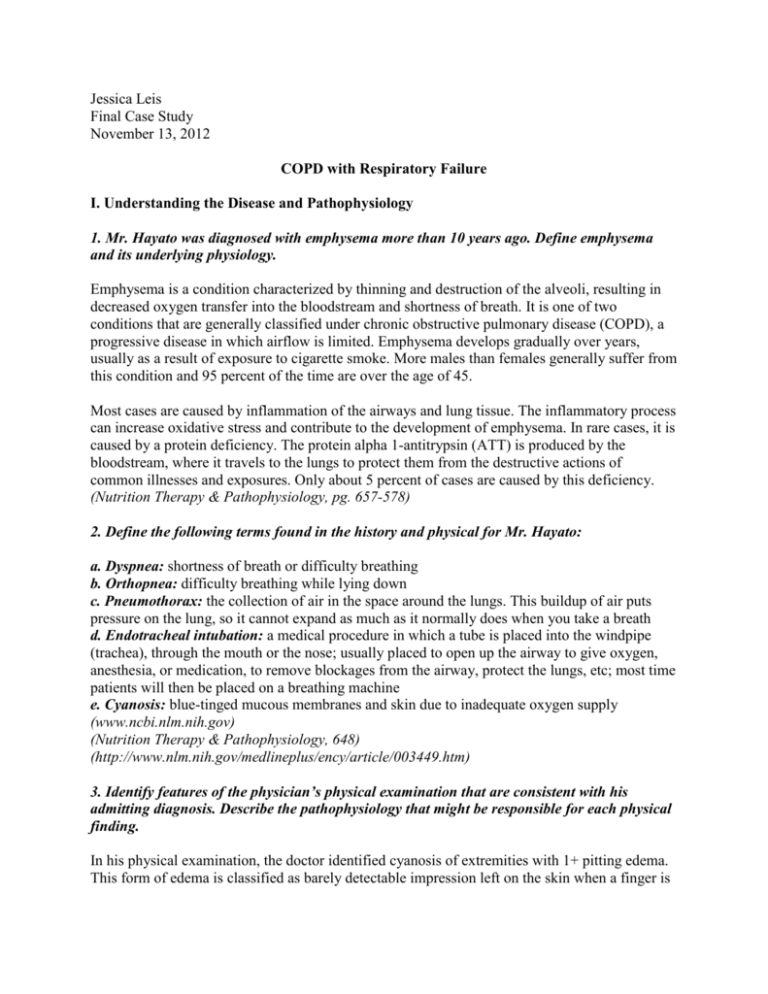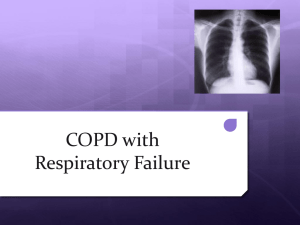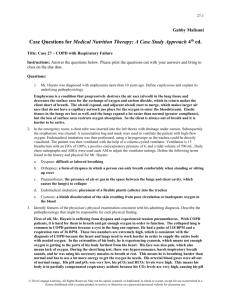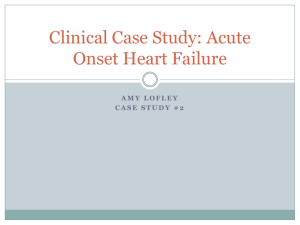Document 9285736
advertisement

Jessica Leis Final Case Study November 13, 2012 COPD with Respiratory Failure I. Understanding the Disease and Pathophysiology 1. Mr. Hayato was diagnosed with emphysema more than 10 years ago. Define emphysema and its underlying physiology. Emphysema is a condition characterized by thinning and destruction of the alveoli, resulting in decreased oxygen transfer into the bloodstream and shortness of breath. It is one of two conditions that are generally classified under chronic obstructive pulmonary disease (COPD), a progressive disease in which airflow is limited. Emphysema develops gradually over years, usually as a result of exposure to cigarette smoke. More males than females generally suffer from this condition and 95 percent of the time are over the age of 45. Most cases are caused by inflammation of the airways and lung tissue. The inflammatory process can increase oxidative stress and contribute to the development of emphysema. In rare cases, it is caused by a protein deficiency. The protein alpha 1-antitrypsin (ATT) is produced by the bloodstream, where it travels to the lungs to protect them from the destructive actions of common illnesses and exposures. Only about 5 percent of cases are caused by this deficiency. (Nutrition Therapy & Pathophysiology, pg. 657-578) 2. Define the following terms found in the history and physical for Mr. Hayato: a. Dyspnea: shortness of breath or difficulty breathing b. Orthopnea: difficulty breathing while lying down c. Pneumothorax: the collection of air in the space around the lungs. This buildup of air puts pressure on the lung, so it cannot expand as much as it normally does when you take a breath d. Endotracheal intubation: a medical procedure in which a tube is placed into the windpipe (trachea), through the mouth or the nose; usually placed to open up the airway to give oxygen, anesthesia, or medication, to remove blockages from the airway, protect the lungs, etc; most time patients will then be placed on a breathing machine e. Cyanosis: blue-tinged mucous membranes and skin due to inadequate oxygen supply (www.ncbi.nlm.nih.gov) (Nutrition Therapy & Pathophysiology, 648) (http://www.nlm.nih.gov/medlineplus/ency/article/003449.htm) 3. Identify features of the physician’s physical examination that are consistent with his admitting diagnosis. Describe the pathophysiology that might be responsible for each physical finding. In his physical examination, the doctor identified cyanosis of extremities with 1+ pitting edema. This form of edema is classified as barely detectable impression left on the skin when a finger is pressed into the skin. The cyanosis of his extremities and this pitting is most likely contributed to Mr. Hayato’s poor ventilation of oxygen to his outer body parts. With less oxygen available to bind with hemoglobin, the number of deoxygenated hemoglobin increases causing blue-tinged mucous membranes and skin. The physician also identified hyperresonance to percussion over the left chest anteriorly and posteriorly. There was also harsh inspiratory breath sounds that were noted over the right chest with absent sounds on the left. This hyperresonance is indicative of decreased breath sounds due to the patient’s increased effort to breath as a result of decreased lung function. This could also be contributed to the pneumothorax that was discovered by the chest radiograph in the ER that showed tension on the left lung. (http://www.meddean.luc.edu/lumen/meded/mech/cases/case8/copdqa.htm) II. Understanding the Nutrition Therapy 4. What is the relationship between nutritional status and respiratory function? Define respiratory quotient (RQ). What dietary factors affect RQ? Weight loss and low BMI have been associated with increased mortality in patients with COPD. Losses of lean body mass is another anthropometric measurement that is generally examined in a nutritional assessment. Excessive weight gain may be deleterious by increasing the workload of an already compromised respiratory system. Individuals who are morbidly obese have difficulty breathing caused by restrictions on the chest wall due to the accumulation of fat in and around the thoracic cage, diaphragm, and abdomen. This results in reduced lung volume accompanied by poor oxygen and carbon dioxide exchange. Respiratory quotient (RQ) is the ratio of the volume of carbon dioxide evolved to that of oxygen consumed by an organism, tissue, or cell in a given time. Due to limited airflow through their airways from either a loss of elasticity and/or inflamed, damaged, or mucous-clogged airways, breathing for COPD patients becomes difficult and the lungs begin to lose their ability to effectively take up oxygen and remove carbon dioxide. Patients are typically thin, if not underweight, and often exhibit extreme weight loss due to the increased energy requirements associated with labored breathing and a once unconscious effort that becomes conscious and difficult. From this increased effort, patients can increase their REE by 10 to 15 percent. If the extra calories being expended are not being replenished in the diet, weight loss occurs. This can also result in malnutrition, which can weaken respiratory muscles, resulting in altered ventilation, poor muscle strength, and impaired immune function. Low dietary intake, from a number of COPD factors, can also be a potential cause for this weight loss often seen in COPD patients. Dyspnea, bloating, anorexia, early satiety, and fatigue can decrease oral intake. 5. Do nutrition support and nutritional status play a role in the ability to be weaned from respiratory ventilator? Explain. Absolutely. In COPD patients, it is important that they receive adequate nutrition, however, overfeeding a patient using mechanical respiration is of primary concern because it can be associated with increased CO2 production. This can further complicate ventilation. Glucose and protein have been show to stimulate ventilatory drive, excess glucose increases CO2 production and can make weaning from ventilation difficult. Despite the potential for increased production, generally, if patients are given moderate total kcal amounts (about 30 percent above their normal basal needs), there is little effect on CO2 production. Overfeeding is the main concern when it comes to producing excess carbon dioxide and weaning an individual from a ventilator. (Nutrition Therapy & Pathophysiology, pg. 662) III. Nutrition Assessment A. Evaluation of Weight/Body Composition 6. Evaluate Mr. Hayato’s admitting anthropometric data for nutritional assessment. Weight: 122 pounds/ 55.5 kg Height: 5’4” / 1.6 m BMI: 55.5/ (1.6)2 = 21.7 kg/m2 IBW: 106 + 5(4) = 126 pounds % IBW: 122 lbs/126 lbs = 97 % UBW: 135 pounds %UBW: 122 lbs/135 lbs = 90% From his anthropometric data, it can be seen that Mr. Hayato is experiencing relatively severe weight loss. Although his BMI at 21.7 kg/m2 does not categorize him as underweight, he is 97% of his IBW and 90% of his usual body weight of 135 pounds, as indicated by his wife. B. Calculation of Nutrient Requirements 7. Determine Mr. Hayato’s energy and protein requirements using the Harris-Benedict equation, the Ireton-Jones equation, and the COPD predictive equations. Compare them. As Mr. Hayato’s clinician, which would you set as your goal for meeting his energy needs? Harris-Benedict (for Men): 66.5 + (13.75 x wt (kg)) + (5 x ht (cm)) – (6.78 x age (yrs)) 66.5 + (13.75 x 55.5) + (5 x 163) – (6.78 x 65) = 1200 kcals energy needs Protein needs: At 20% total kilocalories = 240 kcals or 60 grams protein Ireton-Jones: (5 x weight (kg)) – (11 x age) + (244 if male) + (239 if trauma present) + (840 if burns present) + 1784 (5 x 55.5) – (11 x 65) + 244 + 239 + 1784 = 1800 kcals energy needs Protein needs: At 20% total kilocalories = 360 kcals or 90 grams protein COPD predictive equations: 55.5 kg x 27 kcal = 1500 kcals energy needs 55.5 x 1.5 grams protein = 83 grams protein needs As his clinician, I would recommend Mr. Hayato follow the kcal intake and protein needs calculated using the general COPD predictive equations. The Harrist-Benedict formula tends to underestimate measured REE by 10 to 15 percent, which means it would not be providing Mr. Hayato with sufficient nutrition considering his condition and needs. Providing 25 to 30 kcals/kg of body weight with approximately 20 percent of these kcals coming from protein (at 1.2 – 1.7 grams/kg body weight) would be a good starting place for Mr. Hayato. I determined that an intermediate value of 27 kcals/kg and 1.5 grams/kg protein would be good for Mr. Hayato. 8. Determine Mr. Hayato’s fluid requirements. 1 cc/kcal = 1500 cc fluid (1.5 L) Mr. Hayato needs to stay hydrated with non-caffeinated beverages to help thin the mucous buildup, making it easier for him to cough up. C. Intake Domain 9. From the information gathered within the intake domain, list possible nutrition problems using the diagnostic term. (NI-1.4) Inadequate energy intake (NI-2.1) Inadequate oral intake (NI-3.1) Inadequate fluid intake (NI-5.1) Increased nutrient needs (NC-3.2) Unintended weight loss D. Clinical Domain 10. Evaluate Mr. Hayato’s biochemical indices for nutritional assessment on day 1. pH: 7.2 L, 7.30 L, 7.36, 7.22 L Normal: 7.35-7.45 Glucose: 108 mg/dL (Date: 3/26) and 110 mg/dL (Date: 3/29) Normal: 70 – 110 mg/dL Arterial blood gases: pO2: 56 L, 58 L, 60 L, 57 L Normal: >80 mmHg pCO2: 65 H, 59 H, 50 H, 66 H Normal: 35 – 45 mmHg CO2: 35, 30, 29, 36 Normal: 23-30 mmol/L HCO3 : 38 H, 33 H, 32 H, 37 H Normal: 24 – 28 mEq/L Alk phos: 114 Normal: 30-120 HDL low, LDL high Potentially indicative of malnutrition High neutrophil count, low lymphocyte and monocyte levels - 11. From the information gathered within the clinical domain, list possible nutrition problems using the diagnostic term. (NI-2.1) Inadequate oral intake (NI-3.1) Inadequate fluid intake (NI-5.1) Increased nutrient needs (NC-3.2) Unintended weight loss (NC-2.2) Altered nutrition-related laboratory values IV. Nutrition Diagnosis 12. Select two high priority nutrition problems and complete the PES statements for each. PES #1: Inadequate energy intake related to decreased appetite and low caloric intake as evidenced by unintended weight loss of 13 pounds over the past several weeks. PES #2: Increased caloric needs related to increasing required REE as evidenced by COPD with respiratory failure. V. Nutrition Intervention 13. Mr. Hayato was started on Isosource @ 25 cc/hr continuously over 24 hours. A. At this current rate, how many kcalories and grams of protein should he receive per day? 25 cc/hr x 24 hours = 600 cc/day 1.20 kcal/mL x 600 cc = 720 calories 43 g protein/L 1000 mL = 1 L 0.043 g protein/mL x 600 cc = 25.8 grams protein per day B. Calculate his nutrition prescription utilizing this enteral formula. Include goal rate, free water requirements, and the appropriate progression of the rate. Goal Rate for continuous feeding at 600 cc per day = 600 cc/24 hr = 25 cc/hr To provide 1500 cc, goal rate is: 1500 cc/24 hr = 62.5 cc/hr To progress this enteral feeding rate, tolerance first needs to be established with the 25 cc per hour rate; once tolerance is established, the rate should be increased by 20 cc every 4 hours (as tolerated) to the goal rate of 63 cc/hr. Free water of Isosource: 78% of 600 cc = 468 cc free water 468 cc/4 flushes = 117 cc/flush Flush with 117 cc fluid free water every 5-6 hours to meet fluid needs. 14. What type of formula is Isosource? What is the percentage of kilocalories from carbohydrate, protein, and lipid? Should the patient have been started on a disease-specific formula? Support your responses. What is the rationale for pulmonary formula? Isosource is a complete liquid formula designed for tube feeding patients with increased calorie and protein needs and/or limited volume tolerance. To meet 100 percent RDI (mL), a volume of 1165 mL is needed. Energy provided per mL is 1.20, protein is 43 grams/L, fat is 39 g/L, and carbohydrates provided are 170 g/L. % kcals protein: 18% % kcals carbohydrate: 44% % kcals lipid: 38% Mr. Hayato may have benefited from a disease-specific formula because it would have potentially prevented the need for the change from enteral to peripheral parenteral nutrition back to enteral feedings. However, disease-specific feeds may not be nutritionally complete, they are very expensive, and any available data must be analyzed for benefits before administration. For pulmonary care patients, formulas must be assessed for their sodium, magnesium, phosphate, and potassium levels, density of carbohydrates, protein, and lipid and many other factors to ensure adequate (and not excessive) nutrition. VI. Nutrition Monitoring and Evaluation 15. Examine the patient care summary sheet. How much enteral feeding did the patient receive? The patient received 400 cc of tube feed during his time in the hospital. He received 25 cc/hour for 15 hours, but his TF was discontinued in the evening due to high residuals. During hour 05 (night), increasing the TF to 50 cc was attempted but was not successful. The same was done on hour 10 (day) with no progress. 16. You read in the physician’s orders that the patient experienced high gastric residuals and the enteral feeding was discontinued. What does this mean, and what is the potential cause of this problem? Monitoring gastric residual values is important for assessing the safety of enteral tube feeding. High GRV’s occur when the patient experiences delayed gastric emptying caused by intolerance to the TF. Excessive accumulation of feeding formula and gastric secretions causes distention and greatly increases the potential for regurgitation and vomiting with pulmonary aspiration of gastric contents into the lungs. The determination of high (or low) GRV’s is still up for debate but currently, according to the American Society for Parenteral and Enteral Nutrition guidelines for nutrition support in patients who are critically ill, EN should not be stopped for a GRV of less than 500 mL unless there are other signs of feeding intolerance. (http://www.in.gov/fssa/files/aspiration_prevention_8.pdf) 17. Dr. McFarland elected to begin peripheral parenteral nutrition using a formula called ProcalAmine. She began the PPN @ 100 cc/hr and discontinued Mr. Hayato’s regular IV of D5 ½ NS at TKO. What is ProcalAmine and how much nutrition does this provide? TKO – maintenance rate to keep vein open Mr. Hayato was initially on 5% dextrose and ½ normal saline, a hypertonic standard IV solution. In a hypertonic solution, the osmolality is greater than 340 mOsm/kg. Hypertonic solutions exert more osmotic pressure than the extracellular fluid so when these solutions are infused, fluid gets pulled into the vascular system. Patients on this need to be monitored for fluid overload. He was then switched to PPN with ProcalAmine at 100 cc/hr. ProcAlamine is a 3% amino acid and 3% glycerin formula that is used to help maintain and improve the balance of body protein in patients who require nutritional supplement for a short period of time. It provides utilizable essential and nonessential amino acids, a nonprotein energy source, and a balanced pattern of maintenance electrolytes. The amino acids provide substrates for protein synthesis as well as sparing body protein and muscle mass. Glycerin, the utilizable energy substrate, serves to preserve body protein as well. 1000 mL = 29 grams protein, 130 nonprotein calories 100 cc/hr x 24 hr = 2400 cc/day 2400/1000 = 2.4 x 29 grams protein = 69.6 grams total protein 2.4 x 130 kcals = 312 kcals 18.Was this adequate to meet the patient’s nutritional needs? Explain. No, this was not adequate to meet Mr. Hayato’s needs. ProcalAmine provides nonprotein calories, amino acids, maintenance electrolytes, and water. While his protein needs in the form of broken down amino acids are being met, Mr. Hayato was not being provided with any lipid and was not receiving an adequate amount of calories. 19. Do you feel it was a good idea to begin peripheral parenteral nutrition (PPN)? What are the pros and cons? What are the limitations of using this form of nutrition support? Were other nutrition support options available for the health care team? I do not feel the PPN by itself was necessarily the best route to take. It initially caused a decrease in Mr. Hayato’s respiratory status and once it was discontinued, improvement was made and stability was established. I feel that the doctor should have considered administering PPN in conjunction with smaller enteral feedings. This would have helped lower gastric residuals, increase absorption, and continued the use of the gut to help prevent any muscle atrophy that might occur from not being used. I agree that it was the best route to take as a means of protecting Mr. Hayato and his ability to breathe because it eliminated the chance of aspiration or regurgitation from non-tolerated enteral feeds, but I think it would have been best to pair the peripheral parenteral line with the enteral feeds for the best overall nutrition care. PPN does have its advantages. It is a way of providing nutritional support when GI intolerance prevents oral or enteral feeding. However, it can cause irritation around the site of insertion and is a very expensive method of tube feeding. Also, PN formulas are very complex mixtures that could potentially cause harm to the patient if the correct one is not used. The health care team could have possibly tried bolus, intermittent or cyclic enteral feedings, instead of a continuous drip line, to see if there was any improved tolerance by the GI. Pairing the enteral feeds with PPN may have been a route to try as well, to test Mr. Hayato’s tolerance to smaller enteral feeds while ensuring that he still getting the remaining amount of nutrition he needs to promote healing through a peripheral vein. (http://www.nutritioncare.org/assets/0/48/100/168/172/9EA75C7D-B801-44CB-89BCF5B0290BE699.pdf) 20. On day 4, the enteral feeding was restarted at 25 cc/hr and then increased to 50 cc/hr after 12 hours. You document that the ProcalAmine @ 100 cc/hr was also continued. What would have been the total energy intake for Mr. Hayato? 50 cc/hr x 24 hours = 1200 cc/day 1.20 kcal/mL x 1200 cc = 1440 calories per day 312 calories from ProcalAmine 1440 + 312 = 1712 calories total energy intake 21. Examine the values documented for arterial blood gases (ABGs) A. On the day Mr. Hayato was intubated, his ABGs were as follows: pH 7.2, pCO2 65, CO2 35, pO2 56, and HCO3- 38. What can you determine from each of these values? ABGs are used to determine how well your lungs can transfer oxygen from the air into your blood and how well carbon dioxide can be removed from the body. An ABG is done by taking a blood sample from one of your arteries; the blood is analyzed by a machine that records the amount of carbon dioxide (waste gas) and oxygen in your blood. One of the uses of this test is to determine whether or not you need any extra oxygen. It is also useful in making an initial diagnosis, as well as in determining the effectiveness of treatment, especially in episodes of acute exacerbation. Mr. Hayato’s pH level is low, placing him in a state of acidosis. Normal pH is usually between 7.35 and 7.45. His pCO2, or partial pressure carbon dioxide level, is extremely high indicating that he is not removing the carbon dioxide from his body very efficiently. Common pCO2 levels are around 35 mmHg. His pO2 is low at 56; usually this level is anywhere between 75 and 100 mmHg. His bicarbonate level is high at 38, with a normal range being between 22 and 26 meq/L. This lab data indicates that Mr. Hayato is not exchanging enough carbon dioxide in his lungs and his levels of dissolved oxygen are low. (http://www.livestrong.com/article/199207-arterial-blood-gases-in-copd/) B. On day 3, while Mr. Hayato was on the ventilator, his ABGs were as follows: pH 7.36, pCO2 50, CO2 29, pO2 60, and HCO3- 32. What can you determine from each of these values? With the ventilator, Mr. Hayato’s pH improved to normal values, his pCO2 and CO2 levels decreased (an improvement), his pO2 level increased and improved and his bicarbonate level decreased. Overall, mechanical ventilation had a positive effect on Mr. Hayato’s respiratory status. C. On day 5, after restarting enteral feeding and continuing on ProcalAmine, his ABGs were as follows: pH 7.22, pCO2 66, CO2 36, pO2 57, and HCO3- 37. In addition, indirect calorimetry indicated a RQ of 0.95 and measured energy intake to be 1,350 kcal. How does the patient’s measured energy intake compare to your previous calculations? What does the RQ indicate? Normal RQ, or respiratory quotient, values typically range between 0.65 and 1.25, meaning that Mr. Hayato’s current RQ of 0.95 is good. Using the COPD predictive equation caloric needs for the patient at 27 kcals per kilogram for 55.5 kg body weight, Mr. Hayato’s average energy needs are 1,500 kcals per day. At 1,350 kcals measured energy intake, his needs are close to being met. Using the Harris-Benedict equation, his current intake is exceeding his needs of 1,200 calories per day, however, since this equation typically underestimates needs it is not as accurate. 22. As Mr. Hayato is prepared for discharge, what nutritional goals might you set with him and his wife to improve his overall nutritional status? I would advise Mr. Hayato and his wife to ensure that Mr. Hayato does his best to prevent further weight loss. I would advise that he consume a diet rich in antioxidants, meaning plenty of fruit, vegetable, and fish intake. He should decrease or eliminate his consumption of red meats, refined grains, desserts, and french fries or greasy foods. He should increase his consumption of vitamins A, C, E and beta-carotene to help him cope with oxidative damage that is undergone during exacerbation, which depletes these vitamin stores. I would also instruct Mr. Hayato to consume foods containing phosphorus, so as to ensure adequate phosphate levels within his system to aide in ATP synthesis which is crucial for pulmonary function. I would educate the couple on foods high in calcium and vitamin D as well, to help prevent the risk of osteoporosis. I would create a diet plan example to help them implement small, frequent meals that are high in calories and protein as well as nutrient dense. I would advise Mr. Hayato to rest before meals to avoid fatigue and to alleviate feelings of fullness and bloating. I would also encourage Mr. Hayato to do what exercise he is capable of; this may be strength or resistance training, which has been shown to improve skeletal muscle function. Last but not least, I would reiterate to Mr. Hayato that the elimination of smoking from his list of habits is crucial to enhancing and improving his lung function and overall quality of life. References “ARDS.” (2012). Mayo Clinic. Retrieved from: http://www.mayoclinic.com/health/ards/DS00944. “Chronic obstructive pulmonary disease.” (2009). National Emphysema Foundation. Retrieved from: http://www.emphysemafoundation.org/pulmonary-disease/57-copd.html. Cunha, John. (2012). “ProcalAmine.” Rx List Inc. Retrieved from: http://www.rxlist.com/procalamine-side-effects-drug-center.htm. Fessler, Theresa. (2010). “Gastric residuals—Understand their significance to optimize care.” Today’s Dietitian, 12 (5). Retrieved from: http://www.todaysdietitian.com/newarchives/060210p8.shtml. “Health and safety: Aspiration prevention.” (1993). Bureau of Quality Improvement Services. Retrieved from: http://www.in.gov/fssa/files/aspiration_prevention_8.pdf. Medeiros, D., Wildman, R. (2009). “Advanced human nutrition.” Sudbury, MA: Joans and Bartlett Learning, LLC. Nelms, M., Sucher, K. (2011). “Nutrition therapy and pathophysiology.” Belmont, CA: Wadsworth Cengage Learning. “Peripheral artery disease and intermittent claudication.” (2011). University of Maryland Medical Center. Retrieved from: http://www.umm.edu/patiented/articles/intermittent_claudication_other_symptoms_of_pe ripheral_artery_disease_000102_2.htm. “ProcalAmine.” (2012). U.S. National Library of Medicine. Retrieved from: http://dailymed.nlm.nih.gov/dailymed/drugInfo.cfm?id=66097. “ProcalAmine.” (2012). Drugs.com: Drug Information Online. Retrieved from: http://www.drugs.com/pro/procalamine.html.







